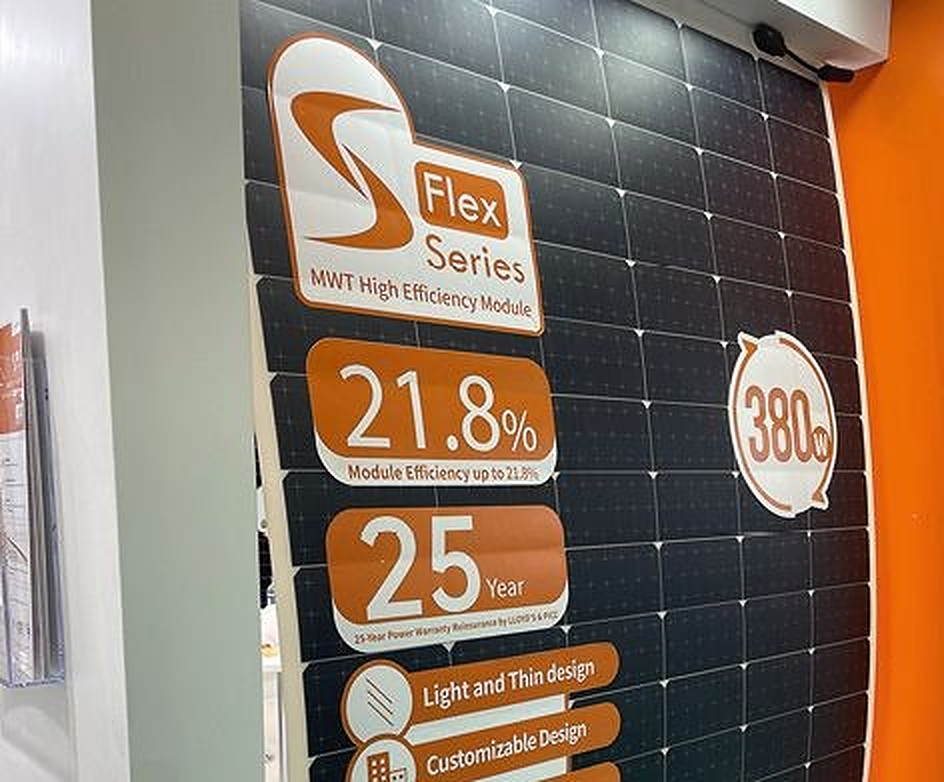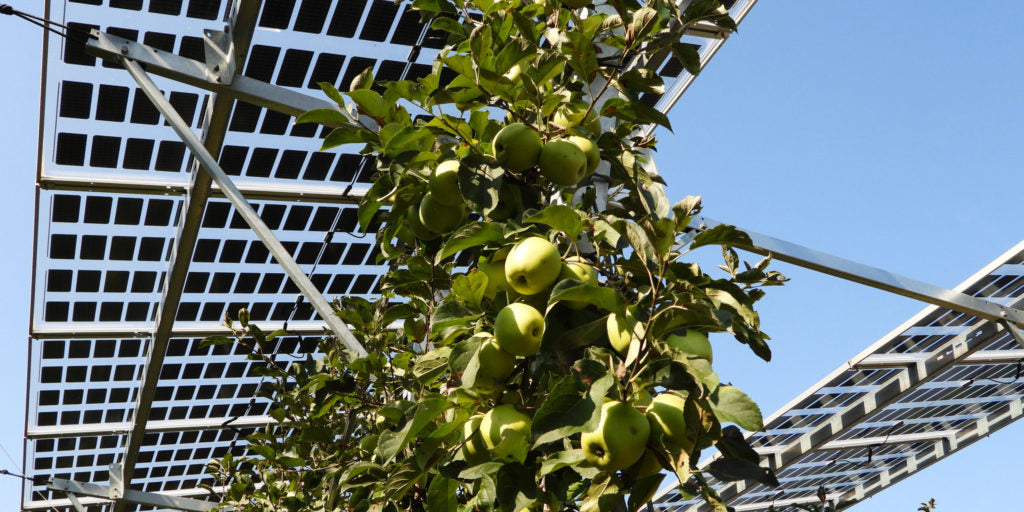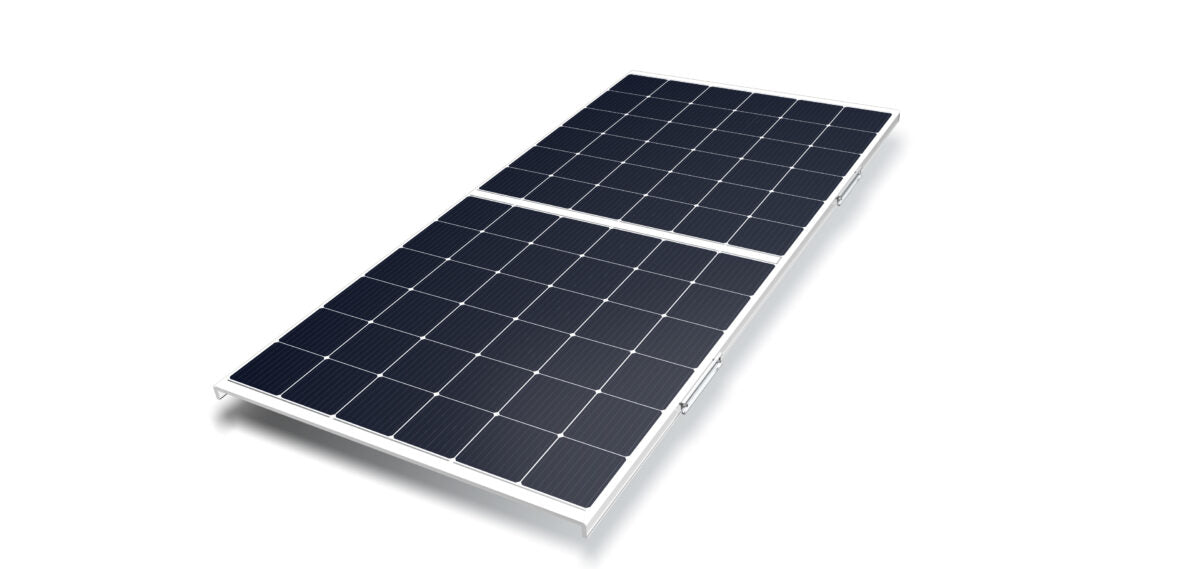https://www.pv-magazine.com/2023/06/03/weekend-read-flex-generation/
Flex generation

The flexible capability of the S-Flex on full display.
Source: pv magazine
It is a claim as old as the modern solar industry: Not all roofs or other surfaces are suitable for traditional, glass-encapsulated solar modules. As a result, specialized modules are required to overcome any obstacles. Products on offer include a wide range of module sizes and dimensions, lightweight versions for roofs unable to bear the glass loads, adhesive installation to avoid penetrating roof surfaces, and even curved or flexible modules able to follow roof contours.
The logic behind this thinking is clear. To achieve the goals of rapid and wide reaching decarbonization, it will be necessary to install solar on as many available surfaces as possible. To some extent there is recent evidence to suggest this is being understood. One example is balcony solar, which became more commonplace in Europe as EU states stared down an energy crisis spurred by Russia’s invasion of Ukraine.
Going back roughly a decade, the first solar technology that attempted to address the need for flexible and lightweight application was thin film – copper indium gallium selenide (CIGS) solar in particular. Manufacturers such as Global Solar and MiaSolé sought to introduce flexible modules that could deliver relatively good conversion efficiency – 10.6% and 14.3%, respectively – in a flexible format.
Both companies struggled to compete, however, and were effectively shuttered by virtue of their acquisition, in 2013, by Hanergy – a company whose shares were subsequently suspended from trading on the Hong Kong exchange for three years before the business withdrew the stock and went private.
Next-gen flex
What a difference a decade makes. At the Solarex trade show in Istanbul, Sunport Power, a Chinese metal wrap-through (MWT) manufacturer, was showing its S-Flex module – a lightweight, flexible product that can achieve 21.8% efficiency and a power output of 365 W to 385 W.
“In Turkey, flexible modules are very new so the reaction is very good,” says Sunport’s marketing director, Katrina Xu, as show attendees paused at the company’s booth to examine the S-Flex. “In March, we were at Solar Solutions and there was a lot of interest because in Europe the residential market is growing well. In Germany, they like to use these modules in balcony applications.”
This year sees Sunport stepping out onto the international stage after more than two years of isolation as a result of China’s strict Covid-19 containment measures. “It was hard for us to go outside China,” says Xu. “With a new product, we need to talk with customers directly. And over the past three years we couldn’t do that.”
The MWT technology deployed in the S-Flex is a back-contact cell in which laser-drilled holes, or vias, are formed through the wafer, enabling the front metallization to wrap through the hole to the rear side. The cell itself, in this case, is a PERC (passivated emitter rear contact) device. The cells are encapsulated in a lightweight but robust polymer material – “2D encapsulation” in company parlance – resulting in a 5.7 kg module that can accommodate a maximum bending radius of 0.3 m.
As a back-contact technology, MWT eschews traditional busbar cell interconnection to instead employ copper frontside metallization and a conductive backsheet. “This makes the technology particularly well suited to flexible encapsulation,” says Xu. “If you make the ribbon on the solar cell, when you bend the module, the welding point will have stress that easily causes micro cracks. And busbar-free design reduces module shading area to increase module conversion efficiency. We just have a self-made copper conductive backsheet. So we don’t have the welding stress. And if you bend it, we won’t have a problem like with the busbar module.”
The coupling of MWT with flexible encapsulation appears to be a neat trick. Suntech pioneer Zhengrong Shi believes so, noting that “because the tabbing is on the same surface, you don’t have to consider the bending.” Since 2018, Shi has been promoting “glass-free” lightweight modules under the brand Sunman Energy.
That the two companies are charting a similar course is not entirely surprising, with Sunport CEO Fengming Zhang the former Suntech chief scientist and both Zhang and Shi being University of New South Wales alumni. Shi says Sunman shipped 200 MW of lightweight crystalline silicon modules in 2022 and expects that to “at least double” this year.
In terms of shipments, Sunport has bigger ambitions. The company is targeting S-Flex sales of between 300 MW and 1 GW this year. “The most important market is Europe but we are also looking at Brazil, Japan, and Australia,” says Sunport’s Xu.
Back-contact benefits
Conductive backsheets offer additional benefits. Endurans, a materials supplier, ships conductive backsheets, primarily to European and North American module makers. Lawrence Theunissen, the business director for the material, likens it to printed circuit boards in the way that it conducts electrons “according to the layout of the cells in the module.” Beyond flexible modules themselves, this functionality delivers “flexibility” to module makers, he says.
Popular content
“Another way to look at flexibility – and this is another big benefit of using conductive backsheets – is the use of flexibility in laying out your electrical pattern,” he explains. “Typically, traditional modules involve a couple of strings within the module – a matrix layout – so it is not too complicated.”
By contrast, Theunissen says, module makers can propose cell configurations to Endurans and a backsheet material can be designed accordingly. This can be particularly useful in emerging PV applications such as vehicle-integrated PV. Endurans worked with Lightyear, a startup, on the aborted development of its solar vehicle the Lightyear 0.
While the Lightyear team failed in their attempt to bring the high-end electric vehicle to market, “they made really good progress, especially on the solar side,” notes Theunissen. The modules Lightyear developed were curved, to suit the aerodynamics and aesthetics of the vehicle. In an attempt to pack as much active photovoltaic area into the limited space, says Theunissen, “the cells are not aligned in a matrix arrangement but in a non-linear way that seamlessly follows the shape of the car.”
Lightyear used interdigitated back contact (IBC) cells in its design, rather than MWT, but both are served by conductive backsheets. The material does come at a higher cost profile, as acknowledged by Endurans, but this is compensated by additional value creation, the company argues.
“For module manufacturers, we have a clear indication that the business case can be even more attractive than for standard modules,” says Theunissen. “There is a higher cost involved but the pricing can be higher at the end-market.” The Endurans director adds that efforts are continuing to reduce material costs, including replacing the copper in the backsheet with aluminum.
Questions remain
Despite the promise of unlocking a wider range of surfaces to PV through new module formats and back-contact technology, the space remains a niche. “The reason solar is going so well is that it is a standardized product with a pretty good lifespan, when installed well,” says Jenny Chase, the Swiss-based head of solar insight at BloombergNEF, a business data company. “That is what is going to make the biggest contribution to tackling climate change.”
Chase does acknowledge, however, that vehicle-integrated PV may offer a “psychological benefit, especially if it is lightweight. Knowing that solar will trickle charge when I’m shopping might give me peace of mind.”
Of the applications that can be addressed by flexible, lightweight solar, she suggests balcony solar might represent “the best of them, because there is some uptake of that.” Ease of installation also offers value to the industry, she said. “There is a bottleneck in Europe, in installation labor.”
For Sunport, the fact that the S-Flex can be installed on rooftops that use sheet metal, without perforating the roof, is a plus. “This product is very suitable for factories that have metal rooftops,” says marketing director Xu. “If you use our flexible module, you can directly use glue and stick it. You don’t have to drill holes on the rooftop which may allow water to get in.”
There are also savings in terms of balance-of-system (BOS) components and labor, says Xu, which compensate for the higher panel price – itself a function of the higher module material costs. “If you see the whole BOS costs – including mounting systems – with conventional modules, and including human resources for installation, then the cost is comparable. We only use glue, so the total BOS is lower.”
There is no doubt that back contact technology, in a variety of formats, is on the roadmap of many module makers – including major producers. Sunport itself was planning to release the next generation of its technology at the SNEC trade show in Shanghai last month.
“It is another back contact technology,” says Xu. “The technology is familiar for us as it is back contact. The surface has no holes, no ribbons, so the aesthetic is very good.”
This content is protected by copyright and may not be reused. If you want to cooperate with us and would like to reuse some of our content, please contact: editors@pv-magazine.com.




